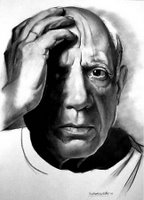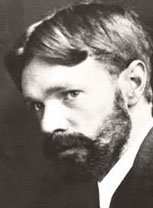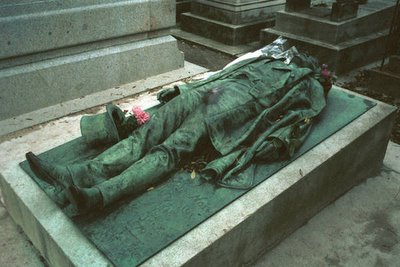Opinion - Ben Macintyre
The Times December 02, 2005
If we think poets and painters have better sex lives, it may be that they are good at persuading us.

“SEX AND ART are the same thing,” declared Pablo Picasso; this was one of the greatest chat-up lines ever, from a master of the art.
Finally, a scientific survey has proven what everyone has long suspected (which is what scientific surveys ought to do): creative artists, it appears, really do have more exotic love lives than the rest of the population. The new study, published this week in Proceedings of the Royal Society, suggests that artists, from poets to painters to puppeteers, have, on average, twice as many sexual partners as non-artists.

Promiscuous Picasso, Lord Byron the philanderer, Dylan Thomas the boozy womaniser: these were not simply bonking Bohemians, it seems, but artists doing what their genes told them to do. According to the researchers the greater the artistic endeavour, the larger the sexual appetites. (There are some obvious exceptions to this rule: Julio Iglesias once boasted that he had had sex with 3,000 women, but has never yet sung a decent song.)
The authors of the study, also suggest a link between artistic sexuality and schizophrenia. The genes linked to schizophrenia appear to be particularly common among poets and artists: the illness may contribute to artistic individuality and a uniquely imagined view of the world, but it may also explain the attractiveness of artists to others, and thus why those traits have been passed on.
Indeed, artistic ability may have evolved as a form of mating display, a courtship technique to attract partners. In his 2001 book The Mating Mind, Geoffrey Miller argued that intellectual and artistic ability were a form of human plumage, designed to entice sexual partners. “Come up and see my etchings” may be a central statement in human evolution.
Artists have more sex, of course, because that is what they are expected to do. As rule breakers, they are assumed to act on impulse, unconstrained by the mores that apply to the rest of society. When Lucian Freud (83) is discovered to be stepping out with yet another nubile lovely, even strait-laced Middle England bottles its outrage, accepting this side-effect of genius.
Artists (Freud excepted) also tend to die young, making it imperative that they gather ye rosebuds while they may. Poets, in fact, die younger than any other sort of artist, and younger than almost any other type of professional, including deep-sea divers.

When Andrew Marvell wrote To his Coy Mistress, he was speaking for all artists who sense Time’s wingéd chariot hurrying near, and want to get laid, a lot, before it runs them over:
Had we but world enough, and time,
This coyness, Lady, were no crime.
Artists are not only expected to have sex more, but also to write, paint, sing, compose and talk about it, endlessly, preferably in smoky bars. For Picasso, sex was a prevailing theme: a recent exhibition in Paris, Picasso Erotique, displayed no less than 330 paintings, drawings, engravings and sculptures portraying sexual congress, or what Gertrude Stein called Picasso’s “dirty side”. Picasso was genuinely interested in sex, all his life, but most modern artists feel obliged to include sex in their portfolios, as a matter of form. Tracey Emin’s installation Everybody I’ve Ever Slept With: 1963-1995 is a very good joke, but also a wry reflection on the modern artist who is obliged either to celebrate sex or to fake it. The Bad Sex awards, presented annually to the most embarrassing description of the sexual act, is never short of contenders.
Artists may not actually have wilder sex lives than mere mortals; they may simply be better at misrepresenting what they do in bed. Jerry Seinfeld once remarked: “Everyone lies about sex. People lie during sex. If it weren’t for lies, there’d be no sex.”

And artists, being imaginative types, can lie better than anyone else. On the other hand, it is de rigueur for a great artist to claim that sex is boring (“The biggest nothing” — Andy Warhol), thus implying that they are at it like rabbits.

D.H Lawrence

“Nothing nauseates me more than promiscuous sex in and out of season,” wrote D. H. Lawrence, simultaneously yawning and panting, to Lady Ottoline Morrell.
The portrait of the artist as a young stud-muffin may have some scientific basis, but it is also a long-running conceit, based largely on wishful thinking. As the artist Dinos Chapman pointed out this week: “The truth is that artists aren’t that special. People just like to think so — especially artists.” But the legend of the artistic and literary libido refuses to die, perhaps because for many people sex has become so desperately cheapened and unromantic.
On the day the sex lives of the artists was unveiled, another, much grimmer report appeared under the less than enticing title Who Pays for Sex? Based on a survey by the Medical Research Council, this showed that the number of men paying for sex has doubled over the last decade, with nearly one in ten of all males admitting that he had done so during the previous five years. The rise of sex tourism, access to sex via the internet, migrant sex workers and rising divorce rates have all contributed to a massive growth in commercial sex. London alone now has an estimated 4,000 massage parlours and escort services. Pornography remains the single most heavily researched subject on the web.
The general devaluation of sex surely explains why, more than ever, we need to associate sex with art, glamour and the carefree misbehaviour of a Picasso or, for that matter, a Kate Moss.
 Lord Byron
Lord Byron
Three weeks after Byron died in 1824, The Times declared him “the most remarkable Englishman of his generation”; this, it should be remembered, was an Englishman who had rogered practically anything with a pulse, including boys, various grandes dames and his own half-sister. He was mad, bad and dangerous to know; and, as an artist, he was fêted for it.
The image of the artist as Don Juan, glamorous and faintly unhinged, with a tangled and athletic love life, owes more to myth than science, but it is one of the oldest and most cherished of our cultural stories. This may be no more than escapism; but so is art.
Keywords: SEX AND ART , Pablo Picasso, Lord Byron, Julio Iglesias, Dylan Thomas sexual appetites,. The Mating Mind, Geoffrey Miller, Lucian Freud Andrew Marvellbut world enough, and time,. Tracey Emin, Andy Warhol, D.H Lawrence, Lady Ottoline Morrell, Dinos Chapman, Kate Moss, Don Juan, Paul Grant,



 Promiscuous Picasso, Lord Byron the philanderer, Dylan Thomas the boozy womaniser: these were not simply bonking Bohemians, it seems, but artists doing what their genes told them to do. According to the researchers the greater the artistic endeavour, the larger the sexual appetites. (There are some obvious exceptions to this rule: Julio Iglesias once boasted that he had had sex with 3,000 women, but has never yet sung a decent song.)
Promiscuous Picasso, Lord Byron the philanderer, Dylan Thomas the boozy womaniser: these were not simply bonking Bohemians, it seems, but artists doing what their genes told them to do. According to the researchers the greater the artistic endeavour, the larger the sexual appetites. (There are some obvious exceptions to this rule: Julio Iglesias once boasted that he had had sex with 3,000 women, but has never yet sung a decent song.) When Andrew Marvell wrote To his Coy Mistress, he was speaking for all artists who sense Time’s wingéd chariot hurrying near, and want to get laid, a lot, before it runs them over:
When Andrew Marvell wrote To his Coy Mistress, he was speaking for all artists who sense Time’s wingéd chariot hurrying near, and want to get laid, a lot, before it runs them over:
 D.H Lawrence
D.H Lawrence
